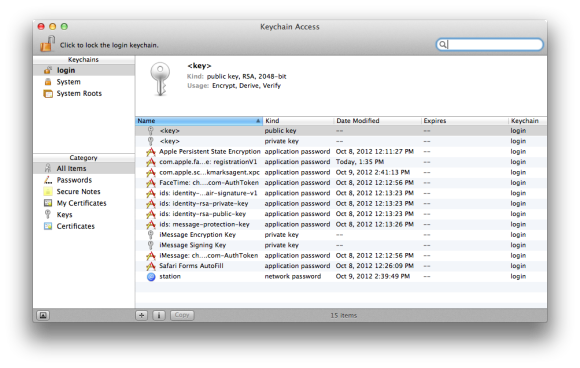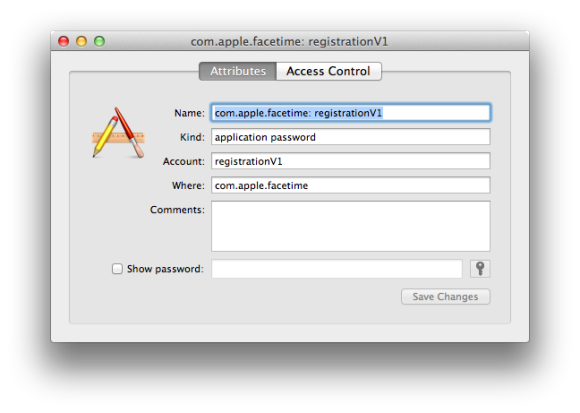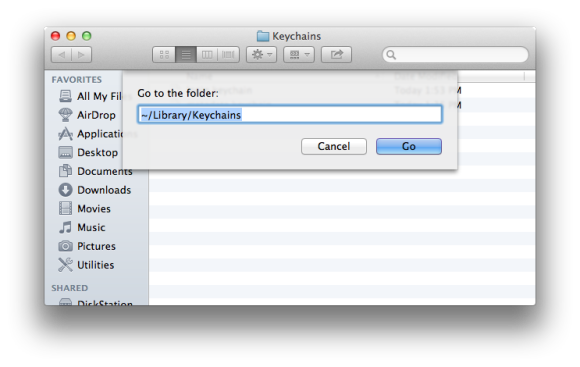Is Administrator's Password the Same as Login Password Mac 2011 Updated FREE
Is Administrator's Password the Same as Login Password Mac 2011
In the innocent days of our computing youth, many of us had to memorize just 1 password—the one nosotros used to transport and call back our e-mail over a glacially slow dial-up connection. User-business relationship passwords? For geeks. Shopping-site passwords? What shopping sites? iTunes Store? App Store? Mac App Store? Didn't be.
In what may seem like a step backward, we now juggle dozens of passwords. We have passwords for logging on to our Macs, accessing our iOS devices, checking our electronic mail, receiving instant letters and texts, purchasing real and virtual appurtenances, yacking on social networking services, streaming music and movies—the list goes on and on.
Fortunately, we no longer need to scribble down each and every password on a hunk of binder newspaper that we tape to our desks in obviously sight. Our Macs can shop these passwords and, in many cases, automatically fill them in when needed. But in that location's more to know near passwords and the Mac's ability to store them than the uncomplicated fact that they exist. Here's a quick guide to what you can—and tin't—practise with Os Ten's passwords.
Keychains are key
Ever since Mac Bone 8.6, the Mac has managed passwords with Keychain, Apple tree'due south password-management system. The Keychain Access application (/Applications/Utilities) is a front end-terminate to that system. It stores a wide variety of items—including passwords for email, websites, servers, network shares, Wi-Fi networks, and encrypted disk images. Additionally, it can store secure notes, private keys, and certificates. Whenever you lot salve a countersign—whether you're prompted by an application or you're saving a website'southward password—information technology'southward stored in the Mac'southward keychain.
The Mac places keychain files in multiple locations—/Organisation/Library/Keychains, /Library/Keychains, and youruserfolder/Library/Keychains. Thankfully, the contents of these various keychain files are combined into Keychain Access, then that you needn't worry about where they're held.
 IDG
IDG Launch Keychain Access, and you'll run across that the window is divided into three panes. The top-left pane lists keychains accessible to you. Beneath this is the Category pane. Here yous tin can choose to view specific kinds of things stored in the keychain—passwords, secure notes, certificates associated with your account, encryption keys, and certificates used broadly past your Mac. The largest pane, to the correct, displays the contents of selected category items—for case, all of the items that have a password associated with them. Except in the case of certificates, you can double-click on one of these items to open up a window where y'all can view the item's attributes—proper noun, kind, associated account, location (a website or network accost)—as well every bit its access control (meaning the applications and services allowed to admission the particular).
Recover passwords
Keychain Access can exercise several useful things. For example, if you lot've forgotten a password and would like to recover it, Keychain Access is the place to go. To learn the identity of a countersign, select All Items or Passwords in the Category pane, then find the the item y'all want the password for and double-click it.
 IDG
IDG In the resulting window, enable the Evidence Password option. You'll be prompted for the password for the login keychain. Enter that and click Permit, and the countersign will exist revealed in the Password field.
If you seek only to recover saved website passwords and are running Safari under Mountain Lion, your job is easier. Launch Safari, open Safari'due south preferences, and click the Passwords tab. All the websites for which you've saved passwords in Safari will appear in a listing. Enable the Prove Passwords option and enter your login password when prompted. Passwords will be listed to the right of each site.
You can besides remove website passwords hither. But select the site you want to delete and click the Remove button. Or, to remove all remembered passwords, click Remove All.
Change the login keychain's password
When yous first set up a user account, the login countersign used for that business relationship is additionally assigned to the login keychain, where new passwords are stored by default. And then y'all can simply enter the password yous use with your account to uncover a keychain particular'southward secrets.
If there'due south a flaw in the Keychain Access security setup, this is it. If someone knows your account's password, they can access the items in this keychain and so discover your other passwords. If you're concerned about that, you can hands change the countersign for the Login keychain.
In Keychain Admission select the login keychain and choose Edit > Change Countersign For Keychain "login". You lot'll be prompted to enter your current password (the 1 you now use for your user account) and then enter and verify a new countersign. Do this, log out of your account and so back in; when the Mac needs to use 1 of the passwords stored in the login keychain, you'll be prompted to enter it. Every bit long equally you're logged in, you shouldn't be troubled for that countersign over again.
Auto-lock the keychain
By default, once you've logged in, your keychain will be unlocked, which isn't terribly secure if others tin access your Mac when you're not around. You tin can add a level of security that auto-locks your keychain. To do that, launch Keychain Access, select your login keychain, and choose Edit > Change Settings for Keychain "login".
The canvass that appears shows two options: 'Lock Later X Minutes of Inactivity' and 'Lock When Sleeping'. If y'all choose the showtime choice and configure it to read something like five minutes, your keychain will lock if information technology hasn't been accessed in the last five minutes. If an application needs access to your keychain after that limit has expired, y'all'll be prompted for your login keychain countersign. Additionally, enable the Lock When Sleeping option, and your keychain locks when your Mac goes to sleep (when you close your MacBook'south chapeau, for instance). Click Save to implement the selected options.
If y'all forget
You've changed the login keychain's countersign and, regrettably, forgotten the new countersign. Is there any promise? Regrettably, no. Apple tree uses the Triple Digital Encryption Security standard (3DES) to secure the keychain. While not the most modern encryption scheme, information technology's quite secure for everyday users—in this case, you lot. Unless y'all can recall your password, you lot're out of luck and must get-go over. To begin that process, we'll make a copy of the old keychain for safekeeping, in case yous call up its countersign; nosotros'll remove information technology from Keychain Access; and then we'll create a new login keychain that you'll employ in the future.
To do that, move to the Finder, select Get > Go to Folder, and enter ~/Library/Keychains. A Keychains folder containing your personal keychains will open up. Locate the login.keychain file and drag it to a rubber place on your Mac (the Documents binder, for example).
Now launch Keychain Access and select the login item that appears in the Keychains pane. It should appear as an empty box, indicating that it'south missing from the Keychains folder. Choose File > Delete Keychain "login". In the sail that appears, click Delete References.
 IDG
IDG Now cull File > New Keychain. In the resulting Salvage dialog box, name the new keychain login and save it to the default location (which is your account's Keychains binder). Y'all'll be prompted to create and verify a password for this keychain. (Be sure to choose a password that y'all'll remember this time.) From this bespeak forwards, passwords that you add together will appear in this keychain. And, yes, you lot'll accept to reenter whatsoever passwords stored in the one-time keychain when prompted.
Should the day come up when your one-time password suddenly dawns on you, do this: In the Finder, open that Keychains folder and remove the current login.keychain file and put it in a prophylactic place. Locate the old keychain whose password you'd forgotten and place it in this folder. Log out of your business relationship and then back into it. In all likelihood you'll be prompted for the password for your keychain by some startup item. When you are, enter the password and the keychain will exist unlocked.
If you have multiple Macs, each one has its own login keychain with its own ready of passwords. Wouldn't it be not bad if each Mac had access to the same keychain? They can. Similar then:
Make a copy of the login.keychain file inside the Keychains folder on the Mac that has the most complete set of passwords, and re-create it to your other Macs. Remove the login.keychain file from each Mac's Keychains folders and put it in a rubber identify in case something goes wrong. Place the copied login keychain file within the user's Keychains folder. Log out and log back in. If your login password on the Mac you're currently using is dissimilar than the one on this primary Mac, you'll be prompted for the login keychain's password. Once you enter it, you should have access to the same passwords as that master Mac.
Is Administrator's Password the Same as Login Password Mac 2011
DOWNLOAD HERE
Source: https://www.macworld.com/article/219714/how-to-manage-passwords-with-keychain-access.html
Posted by: fostercloonstaked.blogspot.com